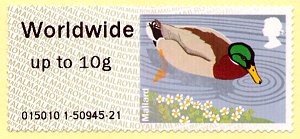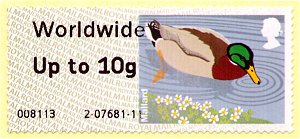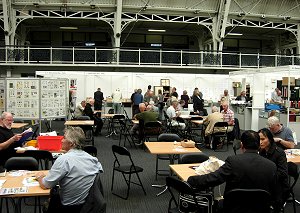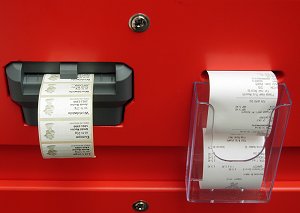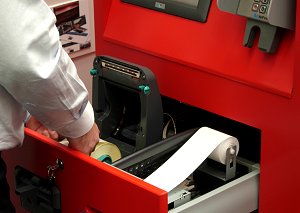| United Kingdom. 2011. The Post&Go postal kiosks (3) |
|
 |
| 2011. Birds of Britain (2) |
After the success of the first series of the Birds of Britain pictorial designs for Post & Go postal kiosks, which were exhausted in a few weeks, Royal Mail decided to continue with these issues, and scheduled 3 new thematic sets for 2011.
(More information about the first series, see article >>>, also published in VARIABLE 18.
More information about the Post & Go postal kiosks, see dossier >>>, also published in VARIABLE 11 and 14). |
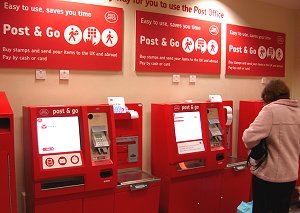 |
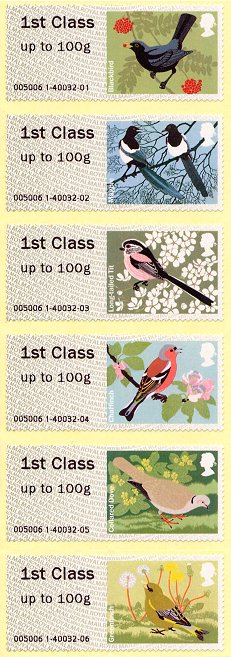 |
The first pictorial set in 2011 was, again, devoted to featuring 6 of the most commonly seen birds in UK gardens and parks, based on the RSPB's Big Garden Birdwatch results, the annual survey organized by the Royal Society for the Protection of Birds. This set is a continuation of the first series issued in September 2010.
As with the previous sets, the rolls of 1,500 thermal self-adhesive labels were manufactured by Walsall Security Printers. The labels are perforated, and the size is 56 x 25 mm. The labels include two vertical phosphorescent stripes, one on each side of the design.
The series is made up from 6 designs by Kate Stephens, based on illustrations by Robert Gillmor. The 6 images appear consecutively on the rolls. However, it is not possible to get the 6 stamps in a single strip, because the Post & Go postal kiosks cut the stamps into strips of 5, maximum. |
| The 6 birds depicted in the second 'Birds of Britain' series are the Blackbird (Turdus merula), Magpie (Pica pica), Long-tailed Tit (Aegithalos caudatus), Chaffinch (Fringilla coelebs), Collared Dove (Streptopelia decaocto) and Greenfinch (Carduelis chloris). |
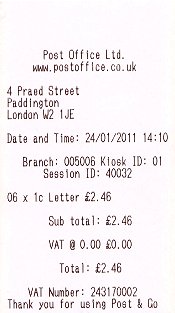 |
| Right, first day receipt of the 6 ATMs |
It is possible to obtain these ATMs with 5 different face values or postage indicators:
- '1st Class up to 100 g' (upper image) and '1st Large up to 100g', for standard and large domestic letters up to 100 g.,
- 'Europe up to 20 g', for letters up to 20 g. to European countries and
- 'Worldwide up to 10 g' and 'Worldwide up to 20 g', for the rest of the world.
The Birds of Britain (II) series could be obtained from January 24th 2011 at the postal kiosks installed in 30 selected post offices around the United Kingdom. In September 2010, a few days before the previous issue, the print settings of all these machines had been altered, by reducing the size of the print font. This was done in all these postal kiosks to reduce the impression size, so as to prevent over printing the bird designs (see article >>>).
| Of these 30 post offices, 6 are in the London area (right image and above, Croydon post office, south London). In addition, and only during the first day of issue, the series could also be obtained in one of the 4 postal kiosks installed in the Ludgate Circus - Tudor Street self-service post office. Therefore, this series could have been obtained, in London, from 16 different postal kiosks, according to the following table: |
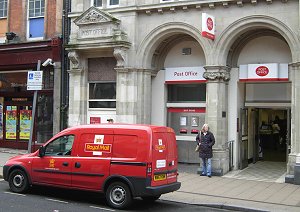 |
| Post office code |
Post office's name |
No. machines |
Code on the ATMs |
| 003009 |
Baker Street |
2 |
003009 1 - 2 |
| 005006 |
Paddington Quay |
2 |
005006 1 - 2 |
| 009013 |
Croydon |
3 |
009013 1 - 2 - 3 |
| 015010 |
Trafalgar Square |
4 |
015010 1 - 2 - 3 - 4 |
| 028003 |
Old Street |
2 |
028003 1 - 2 |
| 030003 |
City of London |
2 |
030003 1 - 2 |
| 242007 |
Ludgate Circus |
4 (only 1 with the series) |
242007 4 |
Like the first Birds of Britain series, these stamps are available in two formats or versions: 1. As part of a sheet sold by the philatelic service (see presentation pack below), with the 6 self-adhesive stamps preprinted with the basic inland postage rate (1st Class up to 100 g), and 2. as variable value stamps - authentic ATMs - issued by the Post & Go postal kiosks, with any of the 5 possible denominations.
| As shown in the images below, except for the security background, which is a little darker on the rolls of labels for the ATMs-, there are no apparent differences in format and illustration of the stamps. It is possible to recognize the origin according to the characteristics of the face value and the code imprints on the left half of the stamps. |
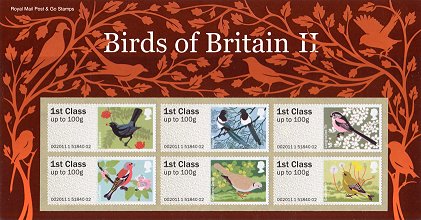 |
The face value pre-printed stamps (image below, left) are only available with the value '1st Class up to 100 g' and the identification code is the same for the 6 stamps, 002011 1 51840 02. 002011 is for the year of issue, 1 indicates the month - January, 51840 is a fictitious session number, and 02 indicates the second pictorial series.
The right image corresponds to an ATM issued by the postal kiosk, with the same face value indicator '1st Class up to 100 g'. All the ATMs have a unique code for each stamp - 005006 indicates the post office (Paddington Quay, in London), 1 is the machine number on that post office, 40032 is the session number, and 01 is the stamp number issued in that session. |
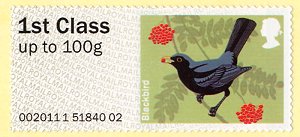 |
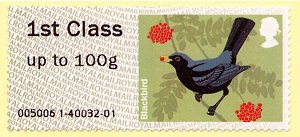 |
Official first day cover with the 6 designs and special postmark.
Some other pictorial postmarks were prepared for this series. |
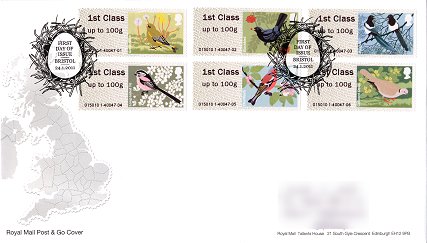 |
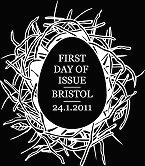 |
| 2011. Spring Stampex 2011 - The trial with the Postal Vision terminal |
Nothing Changes !!. Royal Mail has seen an exciting new business opportunity in Post & Go issues, and is proceeding with new technology and further new issues.
In May 2010, at the London 2010 Festival of Stamps, Post Office Ltd installed a postal kiosk issuing definitive design ATMs with the code 002010 0. Some months later, at the Autumn Stampex 2010, held in September, Royal Mail again installed a postal kiosk, with the code 002010 9-, and released the first pictorial series (see article >>>, also published in VARIABLE 18). A second pictorial set followed in January 2011. All this aroused interest among collectors around the world, and has been a remarkable commercial success for the company.
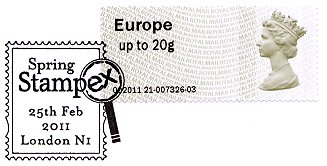 |
Spring Stampex 2011, the new philatelic event organized by the Philatelic Traders' Society and Royal Mail, in the Business Design Centre in London, was held between February 23rd and 26th 2011. On this occasion Royal Mail did not install a Post & Go postal kiosk, but decided to trial a new postal POS terminal. |
| The new Postal Vision 1100 is a postal point of sale terminal developed by the Dutch company Hytech International. It is a modular terminal designed for the management and sale of postal products. It includes a touch screen, where the postal employee can select the products, plus a thermal receipt printer. |
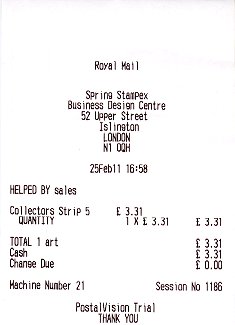 |
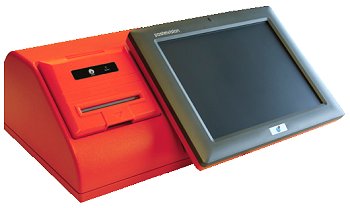 |
During the Spring Stampex 2011, Royal Mail used two Postal Vision 1100 terminals, numbered 21 and 22, on its stand. The Postal Vision 1100 terminal does not print any type of stamp - only receipts. The variable value stamps are printed by a printer connected to the terminal. In the Spring Stampex 2011 they used a Zebra GX420d thermal printer (right).
The machines are configured to issue ATMs similar to those that the Post & Go postal kiosks prepared for the special editions, with a smaller imprint (see article >>>). The printer use the same rolls of labels, and produce a similar impression. |
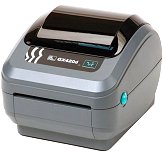 |
During the Spring Stampex this equipment only issued the definitive design - Queen Elizabeth ATMs, which were sold mainly in the form of 'collector strips' with the 5 basic postage values, plus a receipt (upper picture). In addition, they also sold single values and 6-ATM strips. This last option could be in case Royal Mail should decide on the issue of the 6-designs topical birds series.
While the size and printing font are similar, it is possible to recognize some differences between the ATMs issued by the Hytech Postal Vision 1100 terminal during the Spring Stampex 2011 (left column), and the ATMs issued by the Wincor Nixdorf Post & Go postal kiosks (right column).
ATM issued from the Spring Stampex 2011
Postal Vision 1100 terminal
002011 21 - 002011 22
|
ATM issued from the Autumn Stampex 2010
Post & Go postal kiosk
002010 9 |
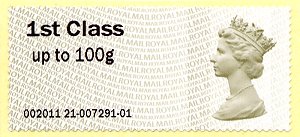 |
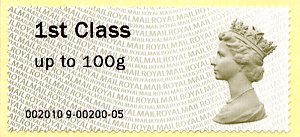 |
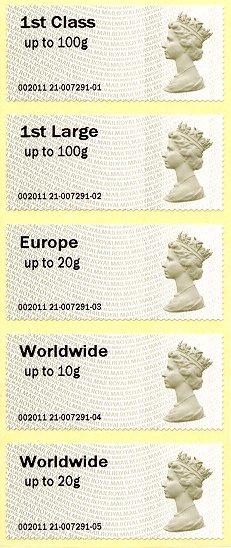 |
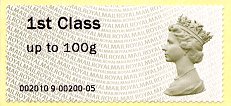 |
- In the postage value indicator, the 2 lines of text are a little bit closer in the first case. Differences can also be found, for example, in the size of the zero.
- The special identification code used in philatelic events starts with the year (2011), and the machine number has 2 digits (21 or 22), instead of one. Therefore, the code of all the ATMs issued during the Spring Stampex 2011 trial begins with 2011 21 or 2011 22. Note also the differences in the format of the figure 1. Following on is the session number, with 6 digits instead of 5, and the stamp number. |
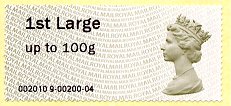 |
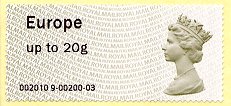 |
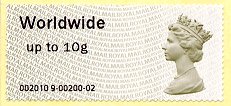 |
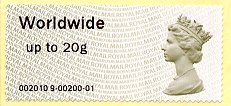 |
Royal Mail could use these terminals at philatelic events and for special issues, to meet the collectors great demands, complementing -or perhaps even replacing- the Post & Go postal kiosk.
| 2011. Birds of Britain (3) |
| The third pictorial set devoted to featuring the most commonly seen birds in UK parks and gardens was available from May 19th 2011. Unlike the previous set, that was only available at 30 selected post offices throughout the country, Birds of Britain III was available from all Post & Go postal kiosks in service on the issue date - 220 machines, installed in 146 post offices. |
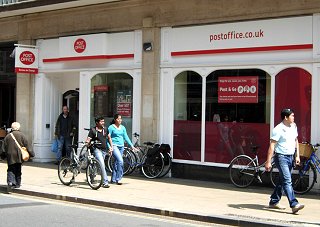 |
| (More information about the first series, see article >, also published in VARIABLE 18. Second series, see article > and in VARIABLE 20. More information about the Post & Go postal kiosks, see dossier >, also in VARIABLE 11 & 14). |
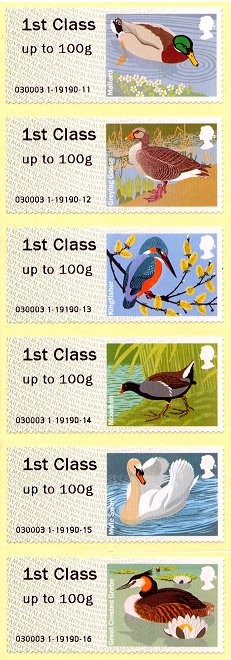 |
As with the previous set, the rolls of 1,500 thermal self-adhesive labels were manufactured by Walsall Security Printers. The size of the labels is 56 x 25 mm., and are perforated. The left half of the label has a neutral background with ROYAL MAIL printed continuously in grey, where the postal kiosks print the face value indicator and the control codes. In the right half, the 6 images making up the series appear consecutively on the rolls. They are designs by Kate Stephens, based on illustrations by Robert Gillmor. The labels include two vertical fluorescent stripes, one on each side of the design. |
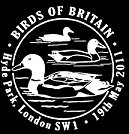 |
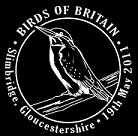 |
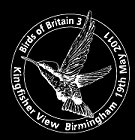 |
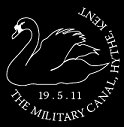 |
| The 6 birds depicted in the third 'Birds of Britain' series are the Mallard (Anas platyrhynchos), Greylag Goose (Anser anser), Kingfisher (Alcedo atthis), Moorhen (Gallinula chloropus), Mute Swan (Cygnus olor) and Great Crested Grebe (Podiceps cristatus). Some first day pictorial special postmarks were available for this series. |
With no changes in the basic programming of the Post & Go postal kiosks, there are ATMs with 5 different face values or postage indicators:
- '1st Class up to 100 g' (upper image) and '1st Large up to 100g', for standard and large domestic letters up to 100 g.,
- 'Europe up to 20 g', for letters to European countries and
- 'Worldwide up to 10 g' and 'Worldwide up to 20 g', for the rest of the world.
The Birds of Britain 3 series was available from all Post & Go postal kiosks. Because of this, Post Office staff, some weeks before the release, started the last phase of software changes in the rest of the postal kiosks, in order to reduce and standardise the impression type.
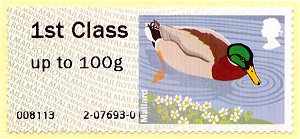 |
On the date of issue of the new set, all kiosks used the same impression, although a few machines, probably between 6 and 10 units throughout the country, had a strange configuration error in which the lower code is broken into 2 separate blocks, with a space between of about 6 mm. |
This configuration error is particularly evident with ATMs having the face value 'Worldwide up to 10g', the only stamps issued from the 'Post a letter' option in the main menu. The images below shows the difference between an ATM with normal imprint (left) and one printed by a kiosk with the error. Note especially the separation in the codes below, and also that the indicator 'Up to 10g' is larger in the second example.
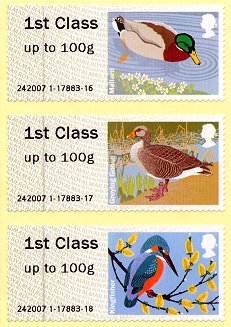 |
One of the collecting curiosities for this series is that there are ATMs with a vertical grey line across the stamp. This is not a printing error by the postal kiosks, but a misprint during the label manufacturing process. It appears intermittently on some rolls and, as can be seen in the left picture, on some consecutive labels. There are ATMs with this error issued by some postal kiosks located throughout the country. |
In addition to the ATMs issued by the Post & Go postal kiosks, with any of the 5 possible denominations, the philatelic service marketed the usual commemorative folder with the 6 self-adhesive stamps preprinted with the basic inland postage rate '1st Class up to 100 g'.
| The folders are designed by The Chase with illustrations by Peter Horridge. They include detailed information about the birds making up the series, and illustrations of their eggs. |
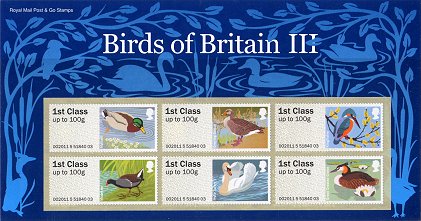 |
It is possible to recognize the origin according to the characteristics of the face value and the code imprints. The pre-printed stamps with face value (image below, left) are only available with '1st Class up to 100 g' and the identification code is the same for the 6 stamps, 002011 5 51840 03. 002011 is for the year of issue, 5 indicates the month - May, 51840 is a fictitious session number, and 03 indicates the third pictorial series.
The right image corresponds to an ATM issued by one Post & Go postal kiosk, with the same face value '1st Class up to 100 g'. The ATMs have a unique code for each stamp - 030003 indicates the post office (in this case, City of London, in Eastcheap, London), 1 is the machine number in that post office, 19190 is the session number, and 11 is the stamp number issued in that session. |
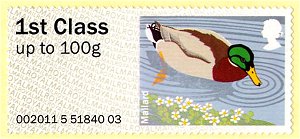 |
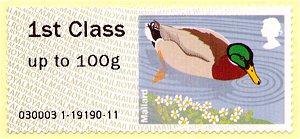 |
| Official first day cover with the 6 designs, and detail of the Bristol commemorative postmark. |
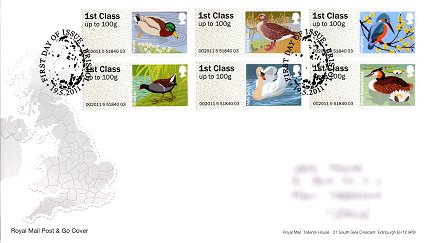 |
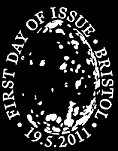 |
| The ATMs at AUTUMN STAMPEX 2011 |
After the successful commercial experience at the London 2010 Festival of Stamps, the Autumn Stampex 2010, and later at the Spring Stampex 2011, with the Post & Go releases and the different postal kiosks and POS terminals, Royal Mail is now giving increasing prominence to these type of items at all major national philatelic events.
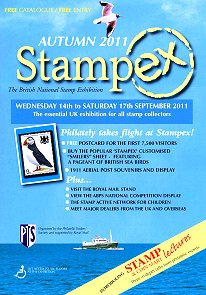 |
Autumn Stampex 2011, the philatelic fair organized by the Philatelic Traders' Society, with the support of Royal Mail, in the Business Design Centre in London, was held from Wednesday September 14th until Saturday 17th 2011.
(For more information, see articles on the Autumn Stampex 2010 >, also published in VARIABLE 18, and the Spring Stampex 2011 >, in VARIABLE 20). |
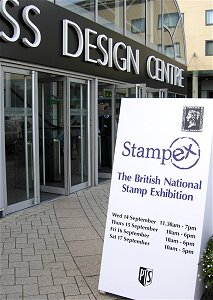 |
As usual, the organizational stands, the philatelic exhibition, and the large Royal Mail stand were located in the hall next to the entrance, with over 100 international trade stands set up in the upper level.
| This time, Royal Mail went one step further in promoting the Post & Go issues, with the installation on its stand of 2 new Postalvision postal kiosks, manufactured by the company Hytech International. |
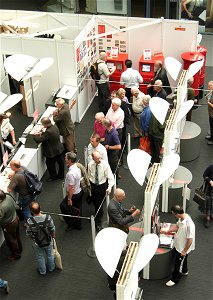 |
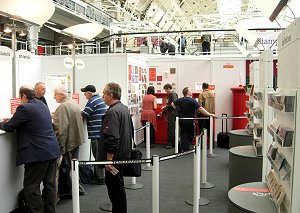 |
The new Postalvision postal kiosks are simple in operation, having a very limited range of options. They are conceived primarily for philatelic purposes, to be used at this type of event.
Using a touch screen, the machine offers different pre-programmed postage values to the user - 6 values were offered at Autumn Stampex 2011, in addition to the 'Collector strip 6' button which issued a strip of stamps with the 6 individual values (see images below): 1st Class', '1st Large', 'Europe up to 20g', 'Worldwide up to 10 g', 'Worldwide up to 20 g' and, for the first time, the new 'Worldwide up to 40 g'.
This sixth value was added to the basic programming to match the number of designs in the pictorial series and the postage values indicators programmed in the postal kiosks. This has been long demanded by collectors, along with cutting the stamps into strips of 6. |
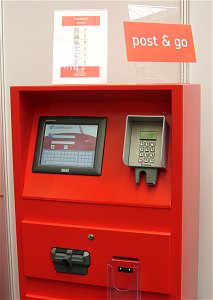 |
The decision to add the high value 'Worldwide up to 40 g' (£1,65, approx. 1.91 EUR in 2011), and no other economic domestic mail postage rate, has upset many collectors, as it has little to do with the basic or more common postal rates in the UK, and is of more to increasing revenue from collectors.
This new value, and quite possibly the option to directly purchase the 6-values 'Collector' strip' could be an added feature in the programming of all Wincor Nixdorf - Post & Go postal kiosks in service in the country. This change is being made in the software and payment module of the postal kiosks, to include a barcode reader (right image), that will also allow the introduction of new postal products and services. |
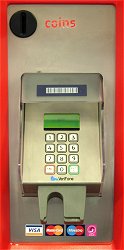 |
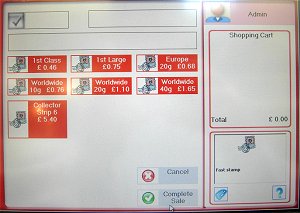 |
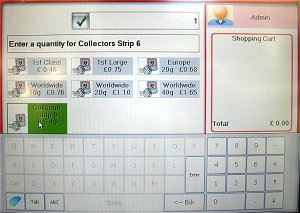 |
After choosing the stamps, the user selects the quantity required, and each product is added to the shopping cart. After the selection, and to minimize operational problems, payment is only possible by bank card. Anyway, during their introduction at Autumn Stampex 2011, the postal kiosks had some malfunctions.
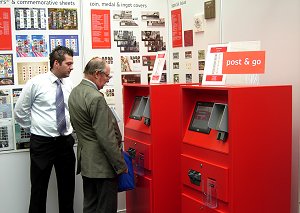 |
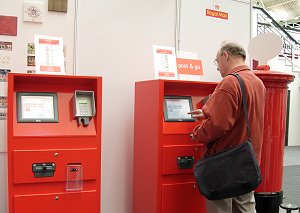 |
After the payment verification, the machine automatically issues a double receipt printed on thermal paper. The first part is a list of stamps purchased (see image in the next section) and the second has the payment details, along with the strip of variable value stamps. For the stamp type printing, these postal kiosks use the same rolls of thermal self-adhesive thermal labels that the Wincor Nixdorf equipment uses, and are fitted with a Zebra GX420d direct thermal printer (image below, right), which prints very quickly. Depending on customer needs, the stamps can be issued in long strips, which the buyer can handle, as the labels are pushed out from the machine, whilst being printed. This raises questions about unsupervised operations of this equipment in a public area.
The two Postalvision postal kiosks were put into service, on September 14th, the day of the opening of Autumn Stampex 2011.
For the occasion, which coincides with the centenary of the birth of Arnold Machin, Royal Mail decided to produce a special temporary imprint using the rolls of basic design labels with the Queen Elizabeth II profile, based on the Machin design.
Both machines were programmed to print the special text 'Arnold Machin1911-1999' in 2 additional lines located between the face value and the stamp code. |
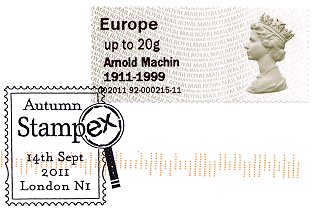 |
| On September 14th, Royal Mail also launched a souvenir sheet of ten 1st Class definitive stamps commemorating the centenary of the birth of the artist, as well as some special postmarks. |
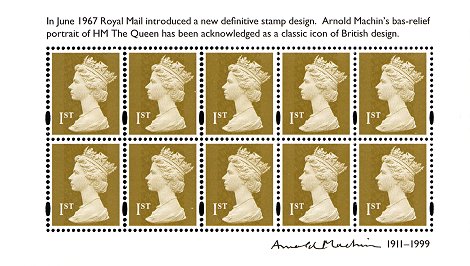 |
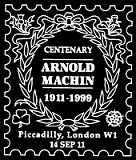 |
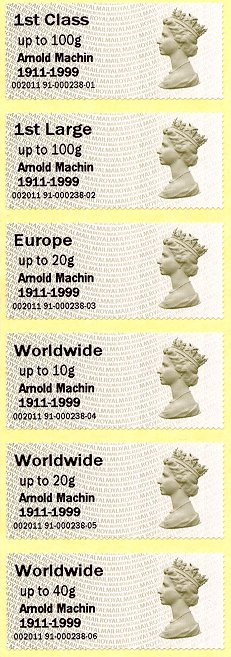 |
In addition to the two postal kiosks for public use, Royal Mail had also two Postalvision 1100 terminals (see article >>>) in the back room, to meet internal orders. The impression made by the 2 machine types is identical, and the stamps issued can only be recognized by the machine number included in the stamp code. This code is formed by the year of issue (002011), the month (September - 9), the machine number (1 -left image- or 2 -upper image- for postal kiosks, and 3 or 4 for the terminals), the session or transaction number (000238 in the strip on the left), and the stamp number in this session (01 to 06 in the picture). Thus, there are ATMs with this special imprint issued by the 4 machines in service at the Autumn Stampex (numbers 91, 92, 93 and 94).
Postal kiosk 92 (code 002011 92 in the stamps - image below) issued ATMs with this design and special imprint during the 4 days of the fair, whilst machine 91 (code 002011 91) issued 'Arnold Machin' ATMs on the 14th and 15th, and the new Birds of Britain (4) series on September 16th and 17th (see next section). |
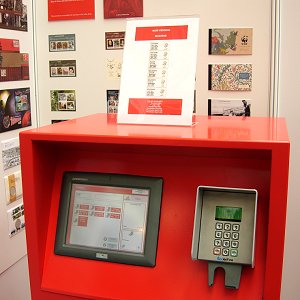 |
| 2011. Birds of Britain (4) |
The fourth and final series devoted to UK birds could be obtained from September 16th 2011, coinciding with London Autumn Stampex 2011. The new series was available at all post offices fitted with Wincor Nixdorf - Post & Go postal kiosks, and in 2 of the Hytech - Postalvision machines (numbers 91 and 93) installed at the philatelic exhibition.
The labels have identical characteristics to the previous series. The rolls are manufactured by Walsall Security Printers and the 6 images making up the series appear consecutively on the rolls. They are designs by Kate Stephens, based on illustrations by Robert Gillmor.
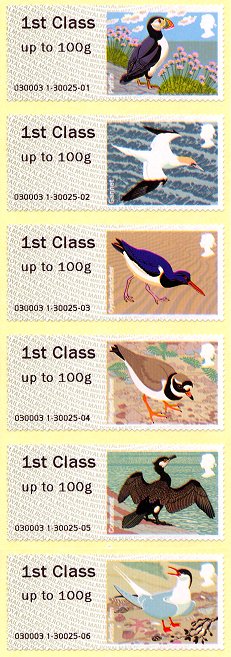 |
The 6 birds depicted in the fourth 'Birds of Britain' series are the puffin (Fratercula arctica), gannet (Morus bassanus), oystercatcher (Haematopus ostralegus), ringed plover (Charadrius hiaticula), cormorant (Phalacrocorax carbo), and arctic tern (Sterna paradisaea). Some first day pictorial special postmarks were available for this series. |
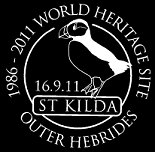 |
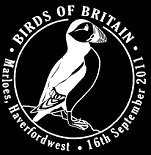 |
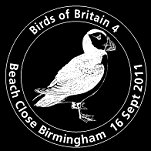 |
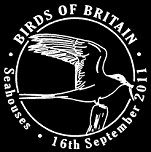 |
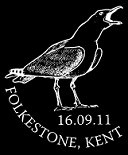 |
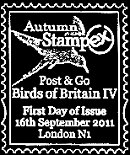 |
According to the current programming in the Wincor Nixdorf - Post & Go postal kiosks, on the date of issue, it was possible to obtain ATMs of this series with the usual 5 face values or postage indicators (first column below):
1. '1st Class up to 100 g' and '1st Large up to 100g', for standard and large domestic letters up to 100 g.
2. 'Europe up to 20 g', for letters to European countries and
3. 'Worldwide up to 10 g' and 'Worldwide up to 20 g', for the rest of the world.
The second column (below) shows the same design and value ATMs issued with one of the machines having the configuration error in which the lower code is broken into 2 separate blocks, as well as the printing difference in the text 'Worldwide Up to 10g'.
In both cases, the complete button set would include 30 ATMs (6 designs each with 5 possible face values).
The third column shows the 6-values set, with the new value 'Worldwide up to 40g', issued by the Hytech Postalvision terminal number 93 (code 002011 93 in the stamps) used at Autumn Stampex 2011. This imprint could also be obtained from the public Postalvision postal kiosk number 91 (002011 91), on September 16th and 17th.
In this case, the complete button set include 36 ATMs, 6 designs each with 6 possible face values, as shown in the receipt on the right. |
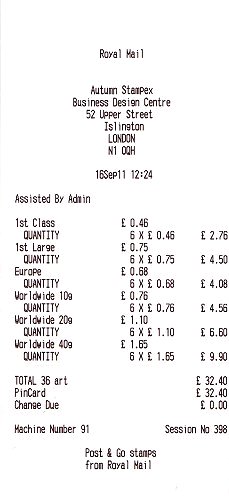 |
Postal kiosk
Wincor Nixdorf |
Postal kiosk
Wincor Nixdorf
(configuration error) |
Terminal
Hytech Postalvision |
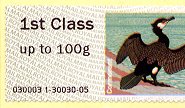 |
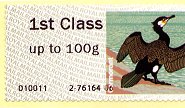 |
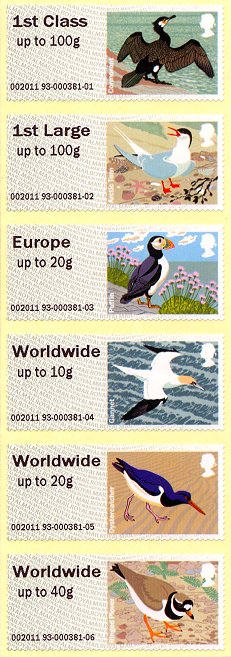 |
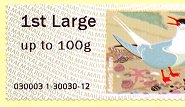 |
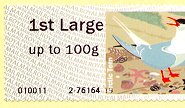 |
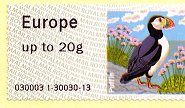 |
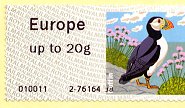 |
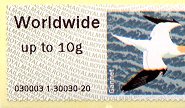 |
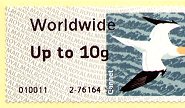 |
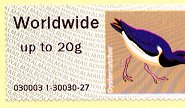 |
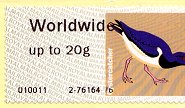 |
| |
|
In addition to the ATMs issued by the Post & Go postal kiosks, the philatelic service, as usual, released a commemorative folder with the 6 self-adhesive stamps preprinted with the basic inland postage rate '1st Class up to 100 g'. In this case the identification code is the same for the 6 stamps, 002011 9 51840 04. 002011 is for the year of issue, 9 indicates the month - September, 51840 is a fictitious session number, and 04 indicates the fourth pictorial series.
| The folders are designed by The Chase, with illustrations by Peter Horridge. They include some information about the birds making up the series, and illustrations of their eggs. |
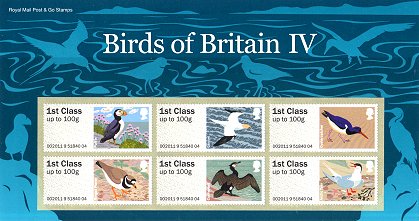 |
| Official first day cover with the 6 designs, and detail of the Bristol commemorative postmark. |
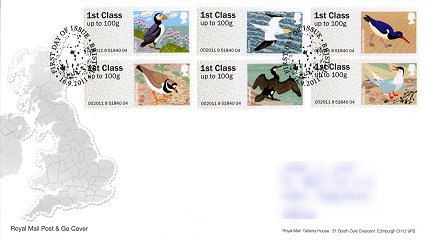 |
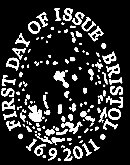 |
Royal Mail plans to continue with new pictorial series in 2012. The first could be devoted to farm animals.
ATM Web - Spain and Latin American Postal Services: http://www.ateeme.net
© J. Jove - M. Sans. ATEEME. Variable value stamps study group. All rights reserved
This page was created in February 2011 and last updated:
10.10.11
. English edition last rewritten by S. Goodman (08.10.2011)
|




























